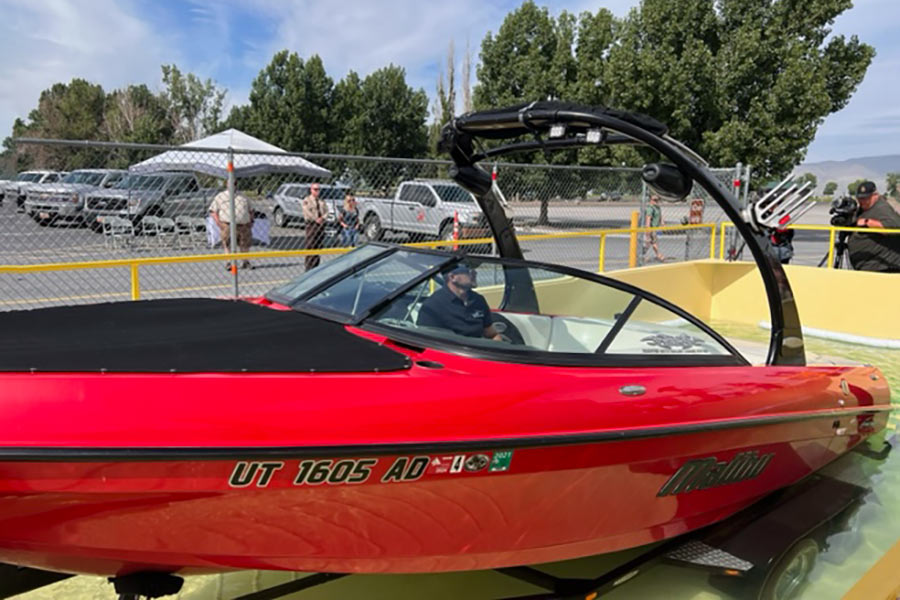New boat decontamination dip tank installed at Utah Lake; other locations announced
Salt Lake City — The first-of-its-kind boat decontamination dip tank was installed at Lake Powell in May 2021 to aid in the fight against invasive quagga mussels. Now, the Utah Division of Wildlife Resources, Clean Wake LLC and Utah State Parks have installed a second dip tank at Utah Lake State Park, and locations for additional dip tanks around Utah have been announced.
Garrett Atwood and Jonas Hyita, founders of Clean Wake LLC, collaborated with the DWR aquatic invasive species team and created the dip tank to provide a faster, more efficient method of decontaminating complex boats to prevent the spread of invasive mussels. These revolutionary dip tanks use a tank, pumphouse, and heating and filtration system, and were awarded a patent in the U.S. and Canada in 2022.
Rather than requiring personnel to climb around and under boats to manually spray hot water during inspections and decontaminations, the dip tank allows boaters to back their watercraft into the 14-foot wide, 5-foot deep tank of 110-degree water to more effectively and thoroughly flush complex intake systems. The dip tank includes built-in guiding tracks to help boaters back their watercraft into the tank. The filtration and pump system will turn over the water in the tank every two hours to keep it clean. The whole decontamination only takes about 5–10 minutes with this system. However, boaters should note that they need two people to use the dip tank — one person to drive the truck and another person to operate the boat.
"This new system has been invaluable in our efforts to stop the spread of invasive quagga mussels," DWR Aquatic Invasive Species Lt. Bruce Johnson said. "It is much faster at decontaminating boats with complex systems and requires less training for our staff. We are so grateful for the ingenuity of Clean Wake LLC, our partnership with various agencies and the legislative funding and support that have made these dip tanks possible. And we are excited to be able to add dip tanks at additional key locations around Utah."
The dip tank at Utah Lake was installed in May 2023 and is located near the entrance to the state park. Similar to the system at Lake Powell, it is free for boaters.
"Utah Lake State Park gets hundreds of thousands of visitors each year, with a good amount of them being boaters," Utah Lake State Park Manager Josh Holt said. "We are excited to continue working with our partners to help stop the spread of invasive mussels."
In addition to the dip tanks at Lake Powell and Utah Lake, dip tanks have also been announced for the following locations, with installation tentatively planned for later this year and in 2024:
- Sand Hollow State Park
- Flaming Gorge Reservoir
- Pineview Reservoir
- Willard Bay Reservoir
"We are thrilled that this system has been proven successful through the initial Lake Powell pilot project that has now been in operation for three boating seasons," Atwood said. "We are excited to partner with the DWR to make the dip tank available at additional sites across Utah. We love Lake Powell and are pleased that our system has made it easier for everyone to enjoy this amazing national recreation area by more efficiently preventing the spread of quagga mussels."
Reminders for boaters
Effective July 1, there are a few changes for those boating in Utah. All boat owners with motorized boats — both residents and non-residents — are now required to pay the aquatic invasive species fee on the DWR website. (This is separate from the boat registration fee that Utah residents pay to the Utah Division of Motor Vehicles.) After making the payments, boaters will be mailed proof-of-registration stickers that must be attached to their boats.
The aquatic invasive species fee is $25 for non-residents and $20 for residents. The funds are used to help prevent quagga mussels from spreading from Lake Powell to other Utah waterbodies.
In addition, resident boaters are also now required to take the annual Mussel-Aware Boater Course, which can be found on the STD of the Sea website. (Previously, the course was only required for non-resident boaters.)
Anyone with watercraft — including kayaks, canoes and paddle boards — is required to stop at open aquatic invasive species inspection stations after leaving a waterbody. Anyone who doesn't stop is guilty of a class B misdemeanor.


















